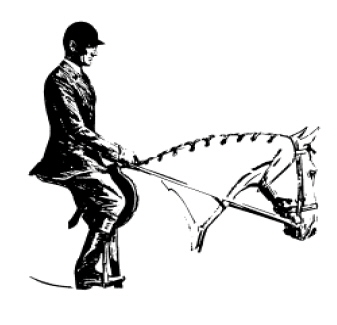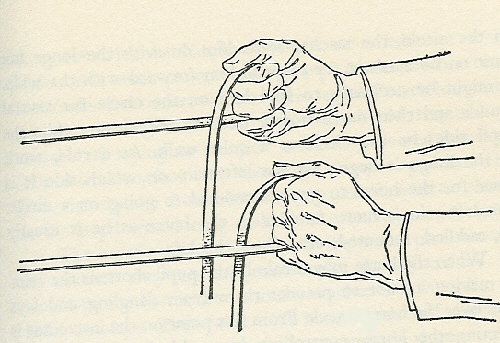IMEHA (International Model Equine Hobbyists Association) was an online photo showing site that existing until 2018. Included on the site were these guidebooks for judging and showing model horses in Performance classes. MEPSA has obtained permission to share the info contained in the guides.
Scoring :: Patterns :: Point Deducts :: Tack :: Rider :: Set-Up Options :: Photo Examples
English Riding is a class that was written for hobbyists and does not exist in the real world. It is run under the same premise as Western Riding but using English style tack. It is open to both hunt seat and saddleseat. The horse is judged on quality of gaits, lead changes at the canter, response to the rider, manners and disposition. The horse should perform with reasonable speed, and be sensible, well-mannered, free and easy moving. Credit shall be given for and emphasis placed on smoothness, even cadence of gaits, and the horse’s ability to change leads precisely and easily rear and front at the center point between markers.
Some breeds have a distinct way of going that represent the huntseat standard for their breed. An example is the BHR Hunter, which is moving in a way that typifies the stock-type hunter but is not indictive of the movement of a sport-type huntseat pleasure mount. Huntseat Arabians tend to have slightly more action, although excessive action should be penalized. Entries that make reference to a breed association or particular national standard (AQHA, USFE, etc.) on the comment line saying that should get extra credit if the model is clearly performing to the standard.
(a) Hunt Seat horses should be suitable to purpose. Hunt Seat horses should move with long, low strides reaching forward with ease and smoothness, be able to lengthen stride and cover ground with relaxed, free-flowing movement, while exhibiting correct gaits that are of the proper cadence. The quality of the movement and the consistency of the gaits is a major consideration. Horses should be obedient, have a bright expression with alert ears, and should respond willingly to the rider with light leg and hand contact. Horses should be responsive and smooth in transition. When asked to extend the trot or hand gallop, they should move out with the same flowing motion. The poll should be level with, or slightly above, the withers to allow proper impulsion behind. The head position should be slightly in front of, or on, the vertical.
(b) Saddleseat horses should move with more animation but still be suitable to purpose.
You Score English Riding Gaits on the following basis:
Faults to be scored according to severity:
(1) Quick, short or vertical strides
(2) Being on the wrong lead
(3) Breaking gait
(4) Excessive speed at any gait
(5) Excessive slowness in any gait, loss of forward momentum
(6) Failure to take the appropriate gait when called for
(7) Head carried too high
(8) Head carried too low (such that poll is below the withers)
(9) Overflexing or straining neck in head carriage so the nose is carried behind the vertical
(10) Excessive nosing out
(11) Failure to maintain light contact with horse’s mouth
(12) Stumbling
(13) If a horse appears sullen, dull, lethargic, emaciated, drawn or overly tired
(14) Consistently showing too far off the rail
Faults which will be cause for disqualification, except in novice amateur or novice youth, which shall be faults scored according to severity:
(1) Head carried too low (such that poll is below the withers consistently)
(2) Overflexing or straining neck in head carriage so the nose is carried behind the vertical consistently
At the option of the judge, all or just the top 12 horses may be required to hand gallop, one or both ways of the ring. Never more than 12 horses to hand gallop at one time. At the hand gallop, the judge may ask the group to halt and stand quietly on a free rein (loosened rein).
If You Use A Doll Rider:
Rider should have a workmanship appearance, seat and hands, light and supple. Hand should be over and in front of horse’s withers, knuckles 30 degrees inside the vertical, hand slightly apart and making a straight line from the horse’s mouth to rider’s elbow. Method of holding reins is optional. All reins are to be picked up at the same time. Eyes should be up with shoulders back, toes slightly out and ankles flexed in. Heels should be down and calf or leg in contact with horse and slightly behind girth.
The rider should sit in a comfortable, balanced, and relaxed manner while maintaining an erect upper body with eyes up and looking forward.
Hunt Seat Rider
Basic Riding Position:
The hunt seat rider’s legs should have a slight bend and hang beneath the rider such that when viewed from a profile, a straight line (approximately) can be drawn through the rider’s ear, shoulder, hip and heel.
The irons should be placed under the balls of the feet and not under the toe or against the heel.
Toes should be turned only slightly out with ankles flexed in toward the horse.
The lower leg should be held such that light contact would be maintained with the horse.
Arms and hands should be held in a comfortable, relaxed manner with upper arms held in a straight line with the body. The elbow is bent such that the lower arm and hands are in a straight line to the bit.
Hands should be slightly over and in front of the withers with knuckles 30 degrees inside the vertical.
Position in Motion:
At the walk and slow trot, body should be vertical with slight motion in the saddle.
At a posting trot, the body should be inclined forward with slight elevation in the saddle.
At the canter, the body should be halfway between the posting trot and the walk.
At the gallop, and while jumping, the body should be at a similar inclination as when at a posting trot.
Saddleseat Rider
Riders should convey the impression of effective and easy control. To show a horse well, the rider should show him/herself well. Ring generalship shall be taken into consideration by the judges. A complete picture of the whole is of major importance. Hands should be held in an easy position, neither perpendicular nor horizontal to the saddle, and should show sympathy, adaptability, and control.
The height the hands are held above the horse’s withers is a matter of how and where the horse carries its head. The method of holding the reins is optional, except that both hands shall be used and all reins must be held up at one time. Bight of the rein should be on the off side. To obtain proper position, rider should place him/herself comfortably in the saddle and find his/her center of gravity by sitting with a slight bend at the knees but without use of irons. While in this position, adjust leathers to fit. Irons should be placed under the ball of the foot (not under the toe or ‘home’), with even pressure on the entire width of the sole and center of the iron. Foot position should be natural (neither extremely in nor out).
Basic Riding Position:
The rider should sit in a comfortable, balanced, and relaxed manner while maintaining an erect upper body with eyes up and looking forward.
The saddleseat rider’s legs should have a slight bend and hang beneath the rider such that when viewed from a profile, a straight line (approximately) can be drawn through the rider’s ear, shoulder, hip and heel.
The irons should be placed under the ball of the foot and not under the toe or against the heel.
Foot should be held in a natural position, neither too far out nor in.
Arms and hands should be held in a comfortable, relaxed manner with upper arms in a straight line with body. The elbow is bent such that the lower arm and hands are in a straight line to the bit. The height the hands are held above the withers is determined by how and where the horse carries its head.
The method of holding reins is optional; however, both hands must be used, and all reins must be picked up at one time. Bight of rein must be on the off side.
Position in Motion:
At the walk, there is slight motion in the saddle with body remaining vertical.
At the trot, there is slight elevation in the saddle. When posting, hips remain under body, not moved in a mechanical up and down or swinging forward backward motion.
At the canter, rider should have a close seat, moving with the horse.
The common mistake among model horse hobbyists is that English Riding is a class for equitation or for enjoyable trail rides. English Riding is an event where the horse is judged on quality of gaits, lead changes at the canter, response to the rider, manners and disposition. The horse should perform with reasonable speed, and be sensible, well-mannered, free and easy moving.
English Riding Class
- The horses will be judged on riding quality of gaits (walk, trot, and canter), change of leads, response to rider, manners, disposition, and intelligence.
- The English Riding class is a competition on the performance of a sensible, well and mannered, and easy moving ranch horse that has the athletic ability and handiness to do a variety of ranch jobs as well as give its rider a pleasant ride over trails or in open country. This competition is not a race or a stunt and should not be confused with equitation classes in which the rider is judged.
- Each horse and rider will perform the English Class riding patterns and routines individually. If the pattern is changed, the contestants should be notified and the pattern to be used should be posted 1 hour before the class is called. The pattern specifications are as follows:
- The eight small circles represent pylon markers, which are recommended. These should be separated by a uniform measured distance of not less than 30 feet nor more than 50 feet on the sides with five markers (see pattern illustrations below). In Pattern I, the three markers on the opposite side should be set adjacent to the appropriate markers. It is recommended that markers be set a minimum of 15 feet from the fence and with a 50- to 80-foot width in the pattern, as the arena permits.
- A solid log or pole should be used that is a minimum of 8 feet in length.
- The long serpentine line indicates the direction of travel and gaits at which each horse is to move. The recommended lead changing point is equal to ½ stride length before or after the center point between the markers. The shaded area represents the lead changing area between the markers. The dotted line (…) indicates walk, the dash line (—) trot, and the solid line (__) canter; the squiggly line (zzzz) indicates the back.
English Riding Patterns
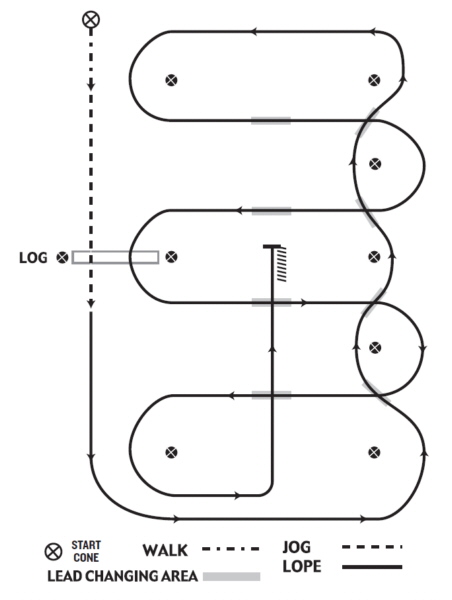
ENGLISH RIDING PATTERN I
START
CONE
1. Walk at least 15’ & trot over log
2. Transition to left lead & canter around end
3. First line change
4. Second line change
5. Third line change
6. Fourth line change canter around the end of arena
7. First crossing change
8. Second crossing change
9. canter over log
10. Third crossing change
11. Fourth crossing change
12. canter up the center, stop & back
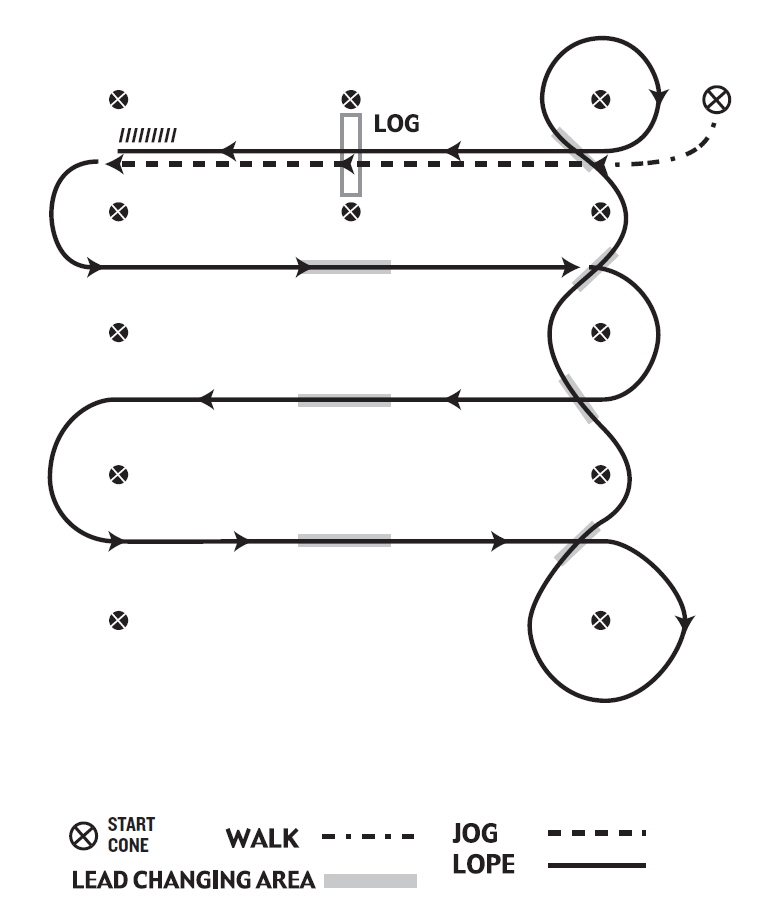
ENGLISH RIDING PATTERN II
START
CONE
1. Walk, transition to trot, trot over log
2. Transition to the canter, on the left lead
3. First crossing change
4. Second crossing change
5. Third crossing change
6. Circle & first line change
7. Second line change
8. Third line change
9. Fourth line change & circle
10. canter over log
11. canter, stop & back
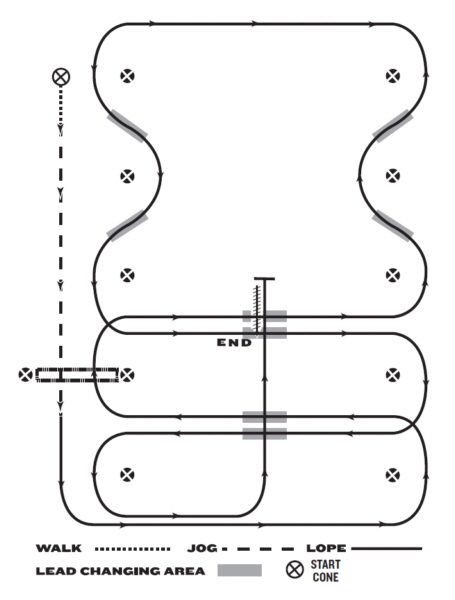
ENGLISH RIDING PATTERN III
START
CONE
1. Walk halfway between markers, transition to trot, trot over log
2. Transition to the canter, on the left lead
3. First crossing change
4. canter over log
5 Second crossing change
6. First line change
7. Second line change
8. Third line change
9. Fourth line change
10. Third crossing change
11. Fourth crossing change
12. canter up the center, stop & back
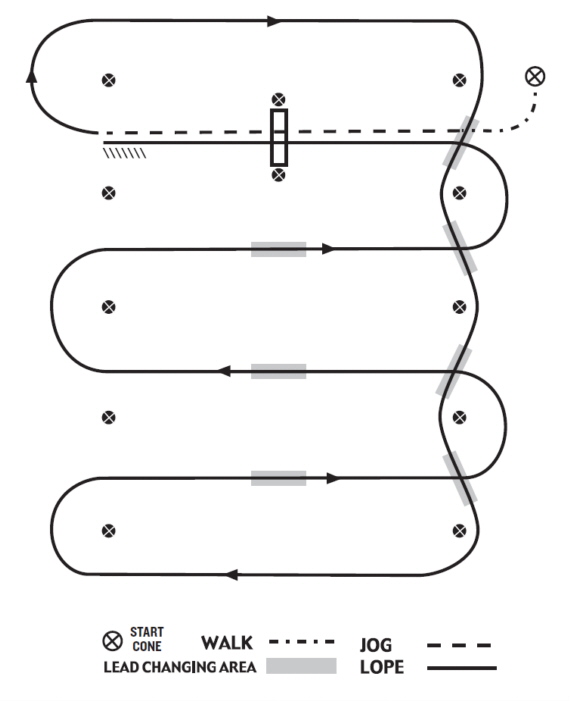
ENGLISH RIDING PATTERN IV
START
CONE
1. Walk, transition to trot, trot over log
2. Transition to the canter, on the right lead
3. First line change
4. Second line change
5. Third line change
6. Fourth line change
7. First crossing change
8. Second crossing change
9. Third crossing change
10. canter over log
11. canter, Stop & back
Scoring the English Riding Class patterns
Maneuvers will be scored on both quality and accuracy. Factors influencing quality include smoothness, speed, and manners. Accuracy involves the precision with which the maneuver is executed. Quality and accuracy points are calculated into an overall (final) score. Scoring system should range from 0 to 100 with 70 points denoting an average performance. Maneuver points are added or subtracted from the overall score on the following basis with points ranging from plus 1.5 to minus 1.5:
| -1.5 | = Extremely Poor | |
| +1.5 | = Excellent | |
| -1 | = Very Poor | |
| +1 | = Very Good | |
| -.5 | = Poor | |
| +.5 | = Good | |
| 0 | = Average |
Maneuver scores are subjective to the judge’s opinion and may vary from judge to judge. Maneuver scores are to be determined independently of penalty points for accuracy
Credits: The following are examples of credits for which points may be added to the maneuver score:
- Clean simultaneous lead changes
- Precision in changing leads near the center point of the lead change area
- Accurate and smooth pattern
- Slower pace while maintaining a collected frame with a consistent footfall pattern
- Ease of guidance and control with rein and leg
- Manners and disposition
- Smooth, level lead changes
- Smooth, clean stop and back, backing readily off diagonal pairs
Faults: The following are examples of faults that may require deductions from the maneuver score:
Excessive opening of mouth, pinning of ears, or wringing of tail by the horse
Anticipation of lead changes
Rough or elevated lead changes
Rough stop, rough back, or both
Excessive stumbling
Propping lead changes (whereby the horse drops a shoulder and elevates on the forehand into the lead change)
Appearance of charging in the lead changes, rushing, or being inconsistent in pace.
Penalties: The following are penalty points that have a specific point deduction as outlined by the American Quarter Horse Association. These penalties are not subjective to the judge’s preference. Judges should familiarize themselves with the following point deductions prior to the class.
5-Point Penalties
- Being out of lead beyond the next designated change area (for example, failures to change, including cross-cantering. Two consecutive failures to change would result in two 5-point penalties.
- Kicking out
- Blatant disobedience (such as bucking)
3-Point Penalties
- Not performing the specified gait (trot or canter) or stopping when called for in the pattern, within 10 feet of the designated area
- Break of gait at the canter
- Simple change of leads
- Being out of lead at or before the marker prior to the designated change area, or out of lead at or after the marker after the designated change area
- Additional lead changes anywhere in pattern (except when correcting an extra change or incorrect lead)
- In Patterns I and III, failure to start the canter within 30 feet after crossing the log at the trot
- Break of gait at walk or trot for more than two strides
1-Point Penalties
- Break of gait at walk or trot up to two strides
- Hitting or rolling the log
- Being out of lead for more than one stride either side of the center point and between the markers
- Splitting the log (log between the two front or two hind feet) at the canter (The horse may accrue, two 1-point penalties if both the front and hind are split.)
½ – Point Penalties
- Tick or light touch of log
- Hind legs skipping or coming together during lead change
- Non simultaneous lead changes (front to hind or hind to front)
Disqualifications (resulting in a 0 score)
- Four or more simple lead changes, failures to change leads, or both
- Illegal equipment
- Willful abuse
- Being off course
- Knocking over markers
- Completely missing log
- Major refusal- stop and back two strides or four steps with front legs
- Major disobedience- rearing or schooling
- Failure to start canter prior to end cone in Patterns I and III
- Failure to follow the correct pattern
- No tie-downs or martingales will be allowed on the horse
Extra Credit Should Be Given If:
(1) Rein contact is steady but gentle at all times. It is referred to as ‘direct contact’ On a model entry this can be achieved by using sticky wax and makes the rein go in a direct straight line from the bit to the rider’s hand with no slack in the rein.
(2) Bight (Excess rein) of rein is draped on the right.
(3) Mane and tail braided with complementary color also should receive extra credit.
(4) an Entry Number is shown on saddle blanket or on rider’s back.
Points Should Be Deducted If:
(1) Model exhibits excessive speed for gait assigned.
(2) Model is on the wrong lead.
(3) Model appears to display a slowness in any gait or loss of forward momentum resulting in an animated and/or artificial gait at the lope.
(4) Rider touches horse or saddle with free hand.
(5) Model’s head is carried too high.
(6) Model’s head carried too low; tip of ear below the withers.
(7) Model is over flexed or has a strained neck in head carriage, so the nose is carried behind the vertical.
(8) Model displays excessive nosing out.
(9) Model displays an open mouth excessively.
(10) Rider uses spurs forward of the heart girth.
(11) Model appears sullen, dull, lethargic, emaciated, drawn or overly tired.
(12) Model appears agitated, has ears back, tail twirled, etc.
(13) Model displays quick, choppy or pony strides.
(14) Reins are draped and not a direct contact.
Required Tack:
Hunt Saddles:
Forward Seat Saddle
Saddleseat Saddles: English Flat Show Saddle
English Flat Cut Back Saddle
English Flat Park Type Saddle
Bridles and Bits: Hunt Seat Bridle w/cavesson noseband and snaffle bit
Full Bridles preferred on Saddleseat.
Double Bridle w/Weymouth
Kimberwicke
Pelham
Tack: A white fitted saddle pad.
In UK No paddle also allowed.
Breast plates
Cruppers
Spurs of the un-rowelled English type
Optional: Riding Crops or whips
Braided mounts (usually on the right side of neck)
Prohibited Tack:
Boots, Martingales, Side Reins, Rein Stoppers, Figure-8, Flash and Drop Nosebands or other devices for controlling the headset are forbidden.
Rider:
Doll are very hard to get in the correct position it often detracts from a good entry more than enhancing it. The best doll to use to get in the correct position is a Mego fully jointed doll. Breyer dolls just can’t cut it.
Hunt Seat Attire
black, brown tweed, brown, dark green or navy blue hunt coat, light shirt with choker (stock pin optional, monograms fashionable) light-colored beeches (no white) with full boots or beige jophpurs with jodhpur boots, hard hat and any long hair should be tied up in a bun or hairnet. Shadbelly coats, bright colors, top hats, and bowlers are not seen (except male riders may wear bowlers if they are wearing tweed or casual ring attire.) This style is appropriate for European entries. Riders may also wear uniforms from Riding Schools just as Spanish Riding School, Oxford Riding School, French Calvary School, etc. The uniform would consist of beeches, uniform jacket, school hat or cap, full boots and white gloves. No Red Hunt Coats.
Saddle Seat Attire
Formal or informal saddle suits are acceptable. Ties are required and gloves are optional, but preferred.
A. Informal—Conservative solid colors are preferred. Solid colors include: black, blue, gray, green, beige or brown with matching jodhpurs (white jacket in season) and derby or soft hat.
B. Formal—Solid colors are: dark gray, dark brown, dark blue, or black tuxedo-type jacket with collar and lapels of the same color, top hat, jodhpurs to match and gloves or dark colored riding habit and accessories. All colors acceptable, but preference is for traditional, conservative colors.
Set-Up Options:
Arena Fencing Required (Indoor or Outdoor Arena)
Types of Fencing Allowed:
- Painted or Natural
- Post and Rail
- Post and Plank
- Chain Link
- Solid Plyboard
- Plyboard with Top Rail
- Post with Drape Rope
- Stock Tube Pipe Rail
- Interior Arena Wall
Footing Required:
- Dirt
- Sand
- No rock base
Backboard or Natural Setting (Indoor or Outdoor)
Examples of English Riding
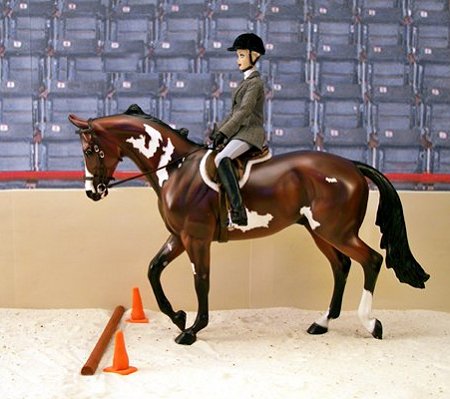
English Riding Entry
A Pirates Life, shown as a bay frame overo TB gelding, is an OF Peter Stone TB, Nite Spot. Owned and shown by Robin Nere. Enter arena at a walk, transition to trot and continue over log.
Doll Rider Correct Seat and Hold the Reins Correctly:

The reins are held between the ring fingers and pinkies with the thumbs solidly on top as they exit the hands. The grip is firm. Close the fingers for optimum communication and safety. Hold the hands just above the horse’s withers, in front of the saddle. Tip the thumbs toward each other at a 45-degree angle. Bend the elbows just enough to create a straight line through the forearms, hands, and reins to the horse’s mouth.
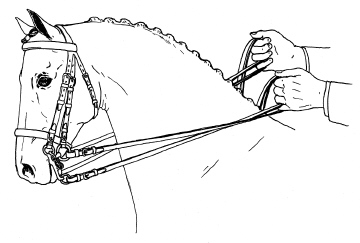
Double Bridle Reins – 2 and 2 Method. Most common handle hold in model horse hobby. It is advised that you put in your comment line what hold your set up is so that judge’s know you understand the three styles on holding the reins.

Double Bridle Reins – 3 in 1 Method. A true challenge for model horse hobbyists and doll rider’s with razor cut slips in the fingers of the hands. Left side curb goes directly back to hand and enters under ring finger with the left snaffle rein coming directly back and entering under the pinky finger with rein crossing over the curb rein. Right side curb rein goes directly back and enters under the middle finger of the left hand with all three reins coming up thru hand and out over the of the index finger with bight cascading down the right side. The right side snaffle goes directly and enters the hand under the ring finger, up into the hand and out over the top of the index finger with the bight draping down the right side. The look gives an ‘X’ to reins the left side of horse’s neck but a two independent rein look to the right side but only one rein going into the right hand. Very tricky set up.
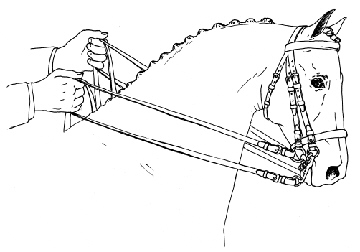
Double Bridle Reins – Fillis Method. The Fillis method of holding the reins is when the curb reins enter the rider’s hand from the bottom, around the little fingers and up to the second joint of the index fingers while the snaffle enters the fist from above over the index fingers. Each hand holds two reins.

